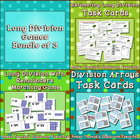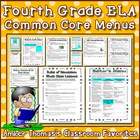One of the best parts of the Journeys reading program in 4th
grade (besides the stories/articles are all really engaging) is the
vocabulary. The words are mostly
"Tier 2," they're repeated in multiple contexts in different texts
students encounter as the week unfolds, they have great activity cards, and the
questions in the teachers book are great.
The way I use their resources are:
1. Read aloud that short text in the TM before the selection
in the student books. I even let my
students have their books open in their lap to the page with all the
"answers" on it. I pause when
I finish a sentence with a vocabulary word in it, and say, "your
vocabulary word is ______." Then
the kids show me one of 3 signs I taught them.
They shrug if they, "never heard the word." They stroke their chin if they, "heard
the word, but can't really explain what it means." And they point to their temple as if to say,
"I know this word, I can tell you about it!"
I call on kids who think they can explain it, and if they
are close but not quite I'll call on another child and ask, "Can you add
to the definition?" In the end if I
need to clarify I will.
2. The words appear
in the anthology and leveled readers, so kids get lots of exposure to the words
in multiple contexts, which helps so much.
3. I use the cards
that come with the series. I have the
children sit in a circle, and pair highly verbal students with lower ones. I hand out a card to each pair, and they have
2-3 minutes to talk about the photo and contextual sentence, as well as ask
each other the questions on the back. I
set a timer to go off when time is up, and then the children pass their card
clockwise. This continues until every
pair has seen all 10 cards. I stay in
the center of the circle to man the timer and also to provide guidance (or a
substitute partner if someone has to use the restroom!).
4. I administer the
vocabulary portion of the weekly quizzes.
.jpg) So really, the only missing piece
in this puzzle was homework. There just
isn't much (or any?) in the students' workbook.
I don't understand why this piece is missing! Sure, I could assign the old, "write a
sentence for each vocabulary word" standby assignment. And then I'll get such gems as:
So really, the only missing piece
in this puzzle was homework. There just
isn't much (or any?) in the students' workbook.
I don't understand why this piece is missing! Sure, I could assign the old, "write a
sentence for each vocabulary word" standby assignment. And then I'll get such gems as:
1. I
know how to spell original.
2. I
know what original is.
3. I
don't know what original means.
4. Do
you know what original means?
I was a kid once. I INVENTED those sentences. I learned percents by figuring "if I have 20 words, I can get away with 4 crummy sentences. Which 4 do I least want to come up with a good sentence for?"
So with these other great
activities at their disposal, I decided that those questions that appear only
in the TM don't need to be used as discussion points, they would work great for
homework practice. By creating a
template worksheet that includes a big text box in the middle for photocopying
those questions, I get WAY better sentences now than I did before.
 I even get the added bonus of teaching and
re-teaching the skill of rephrasing the question in the form of an
statement. I hope this template provides
a nice addition to your vocabulary instruction if you are using Journeys. This Journeys vocabulary template is available for free in my Teachers Pay Teachers store. If
you use Journeys, I hope you find it useful!
I even get the added bonus of teaching and
re-teaching the skill of rephrasing the question in the form of an
statement. I hope this template provides
a nice addition to your vocabulary instruction if you are using Journeys. This Journeys vocabulary template is available for free in my Teachers Pay Teachers store. If
you use Journeys, I hope you find it useful!
 I even get the added bonus of teaching and
re-teaching the skill of rephrasing the question in the form of an
statement. I hope this template provides
a nice addition to your vocabulary instruction if you are using Journeys. This Journeys vocabulary template is available for free in my Teachers Pay Teachers store. If
you use Journeys, I hope you find it useful!
I even get the added bonus of teaching and
re-teaching the skill of rephrasing the question in the form of an
statement. I hope this template provides
a nice addition to your vocabulary instruction if you are using Journeys. This Journeys vocabulary template is available for free in my Teachers Pay Teachers store. If
you use Journeys, I hope you find it useful!




















